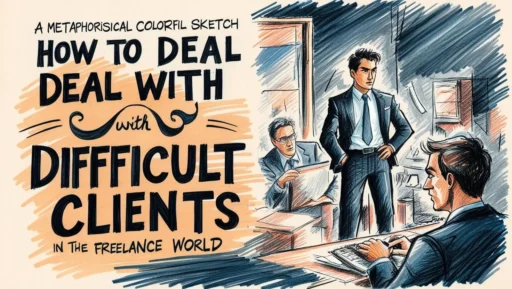Every freelancer, regardless of their skill, experience level, or how carefully they vet potential projects, will eventually encounter a difficult client. It’s a rite of passage in the world of self-employment. These challenging situations can arise from a simple mismatch in communication styles, a misunderstanding of the project scope, or unrealistic expectations. The stress and anxiety they cause can be immense, tempting you to question your skills or even your career choice.
But challenging clients don’t have to derail your business. In fact, learning to navigate these turbulent waters with grace and strategy is a core freelance superpower. Handling difficult situations deftly can turn a potential setback into an opportunity for growth, strengthening your business practices and building your confidence. Sometimes, you can even transform a rocky relationship into a loyal, long-term partnership. This guide explores the most common types of difficult clients and provides actionable strategies to manage them, helping you protect your boundaries, your sanity, and your bottom line.
The Rogues’ Gallery: Common Types of Difficult Clients
Recognizing the type of difficult client you’re dealing with is the first step toward managing them effectively. Their behavior often stems from a specific motivation, and understanding that can help you respond with empathy instead of frustration.
- The Ghost: This client is enthusiastic at the start, but disappears the moment you deliver work or send an invoice. Their communication goes silent, and they are perpetually slow to approve work and process payments. Their motivation is often disorganization, not malice.
- The Micromanager: This client hovers over every detail, requests constant updates, and questions your professional expertise at every turn. They might ask for daily reports or want to be CC’d on every internal email. Their motivation is typically anxiety and a fear of not getting their money’s worth.
- The Scope-Creeper: Famous for the phrase, “Could you just quickly…?”, this client constantly asks for “little extras” that fall outside the agreed-upon scope. These small requests accumulate, bloating the project and eating into your profits. Their motivation is often genuine excitement, but they don’t understand professional boundaries.
- The Indecisive: This client cannot make a firm decision. They change their mind mid-project, provide conflicting feedback, and seem paralyzed by choice. Their motivation is a fear of making the wrong decision, and they want you to resolve their internal conflict.
- The Bargain-Hunter: This client questions every line item on your invoice, constantly pushes for discounts, and believes everything is negotiable. Their motivation is to “win” the transaction, often seeing price as the only measure of value.
- The Vague Client: This client provides a disorganized or incomplete brief, is unclear about their goals, and expects you to read their mind. This lack of clarity is a recipe for endless revisions and frustration. Their motivation is often a simple lack of understanding of what they actually need.
Setting Yourself Up for Success: Prevention is the Best Medicine
The best way to handle a difficult client is to avoid working with them in the first place. A robust client onboarding process is your first line of defense.
- Vet Clients Thoroughly: Have a mandatory discovery call before accepting any project. Use this call to gauge their communication style and professionalism. Ask questions like, “Can you describe a past project with a freelancer that went really well? What made it successful?” Their answer will reveal what they value.
- Use an Ironclad Contract: Your contract is your most important tool. It must clearly outline the full scope of work, deliverables, timelines, and the number of revision rounds included. Crucially, it must also define what is not included to prevent scope creep.
- Establish a “Communication Plan”: In your contract or proposal, include a section that defines your working hours, preferred communication channels (e.g., email for official requests, a project management tool for updates), and your standard response time. This sets professional boundaries from day one.
Best Practices When Challenging Situations Arise
When a project starts to go sideways, your response will determine the outcome.
Stay Calm and Professional
Never respond to a difficult message out of anger or frustration. If you receive an inflammatory email, use the 24-Hour Rule: wait a full day before you draft a reply. Keep all your communications factual, objective, and unemotional. This not only de-escalates the situation but also creates a professional paper trail.
Lead with Empathy, Follow with a Boundary
Start your response by acknowledging their feeling, then gently but firmly restate your boundary or process.
- For the Micromanager: “I appreciate your deep involvement in this project. To ensure I can focus on delivering the best creative work, my process includes a comprehensive progress update every Friday. I will be sure to address all your points in that update.”
- For the Scope-Creeper: “That’s a fantastic idea! It falls just outside the scope of our current agreement, but I would be happy to draft a separate addendum and quote for it. Would you like me to put that together for you?” This response is positive and helpful, yet it clearly draws a line and creates a path for you to be paid for extra work.
Offer Solutions, Not Excuses
When a client is indecisive or unhappy, they are looking for you to lead them to a solution.
- For the Indecisive: Instead of asking an open-ended question like, “So, what do you want to do?”, provide a professional recommendation. “Based on our goal of increasing conversions, I recommend Option A because it has a clearer call-to-action. Shall we proceed with that?”
- When You Make a Mistake: If you genuinely make an error, own it immediately and offer a solution. “You’re right, I overlooked that detail. I have already corrected it, and I will implement a new checklist item to ensure it doesn’t happen again. Thank you for catching it.” Clients value honesty and responsibility far more than perfection.
Know When to Walk Away
Sometimes, a client relationship is simply unsalvageable. If a client is disrespectful, unethical, or causing significant harm to your mental health, it is okay to terminate the contract. Review the termination clause in your agreement and send a professional, unemotional email that outlines the final steps for hand-over and payment. Exiting gracefully, without burning bridges, is the mark of a true professional.
Protecting Your Well-being is Non-Negotiable
Difficult clients are emotionally draining. It is crucial to have support systems in place. Create a “peer support” group with other freelancers where you can share experiences and get advice. After a tough project ends, take time to debrief, extract the lessons learned, and then emotionally let it go. Do not carry that stress into your next project.
Conclusion: Every Difficult Client Is a Lesson in Disguise
Navigating challenging client dynamics is an advanced skill that separates thriving freelancers from struggling ones. Each difficult encounter, while stressful in the moment, is an opportunity to refine your contracts, improve your communication strategies, and strengthen your professional boundaries. By approaching these situations with a calm demeanor, strategic communication, and a clear sense of your own value, you ensure that your freelance career remains rewarding, healthy, and built for the long haul.

